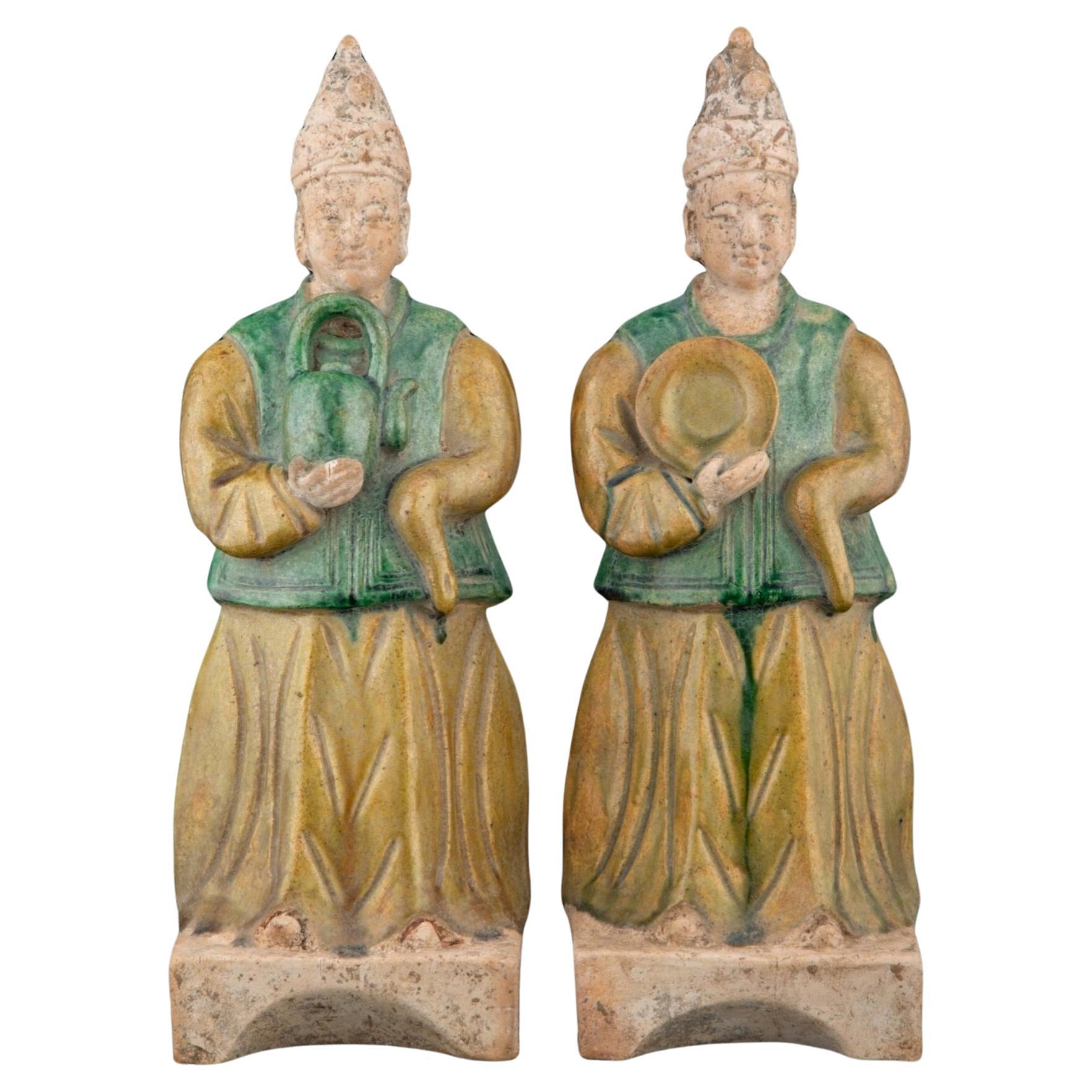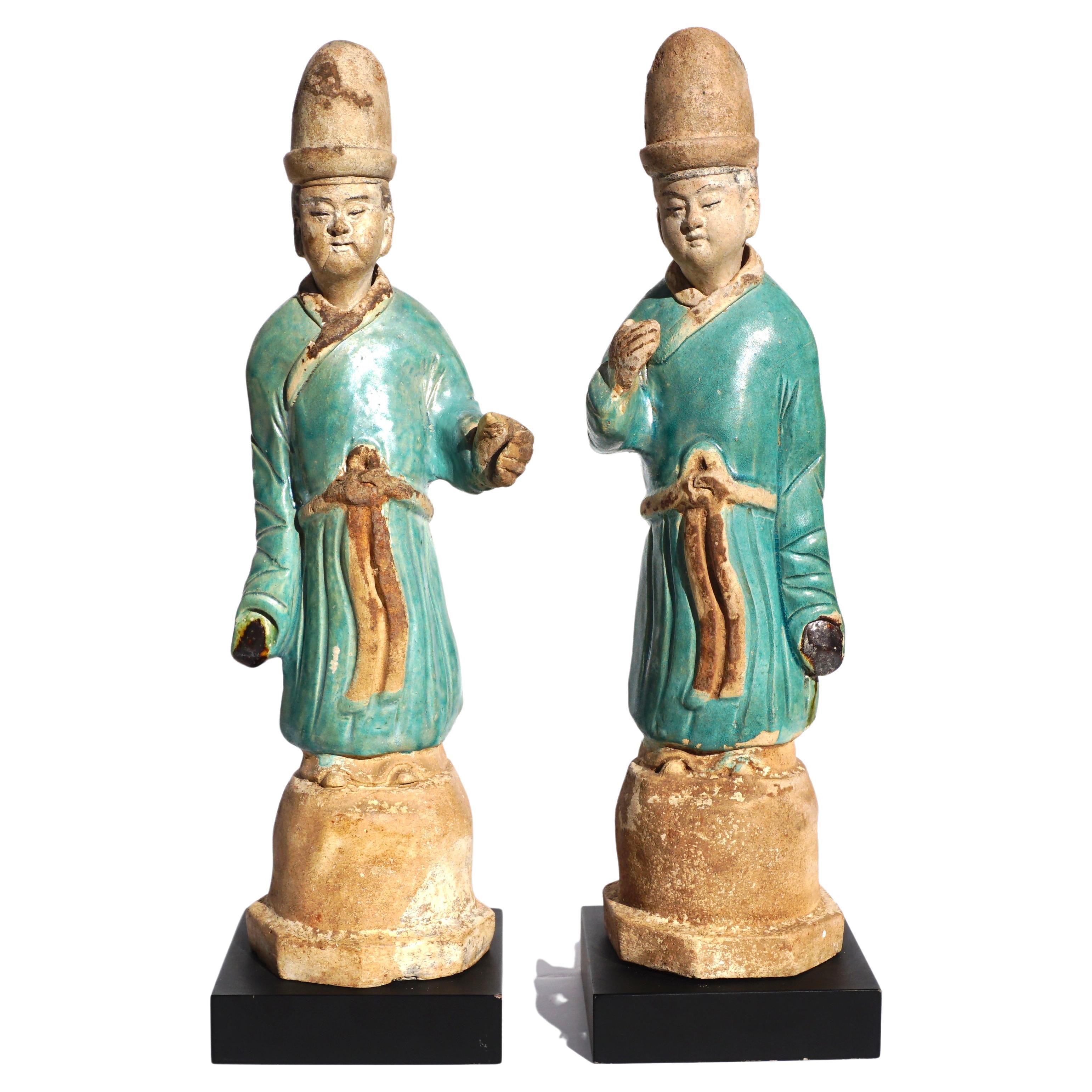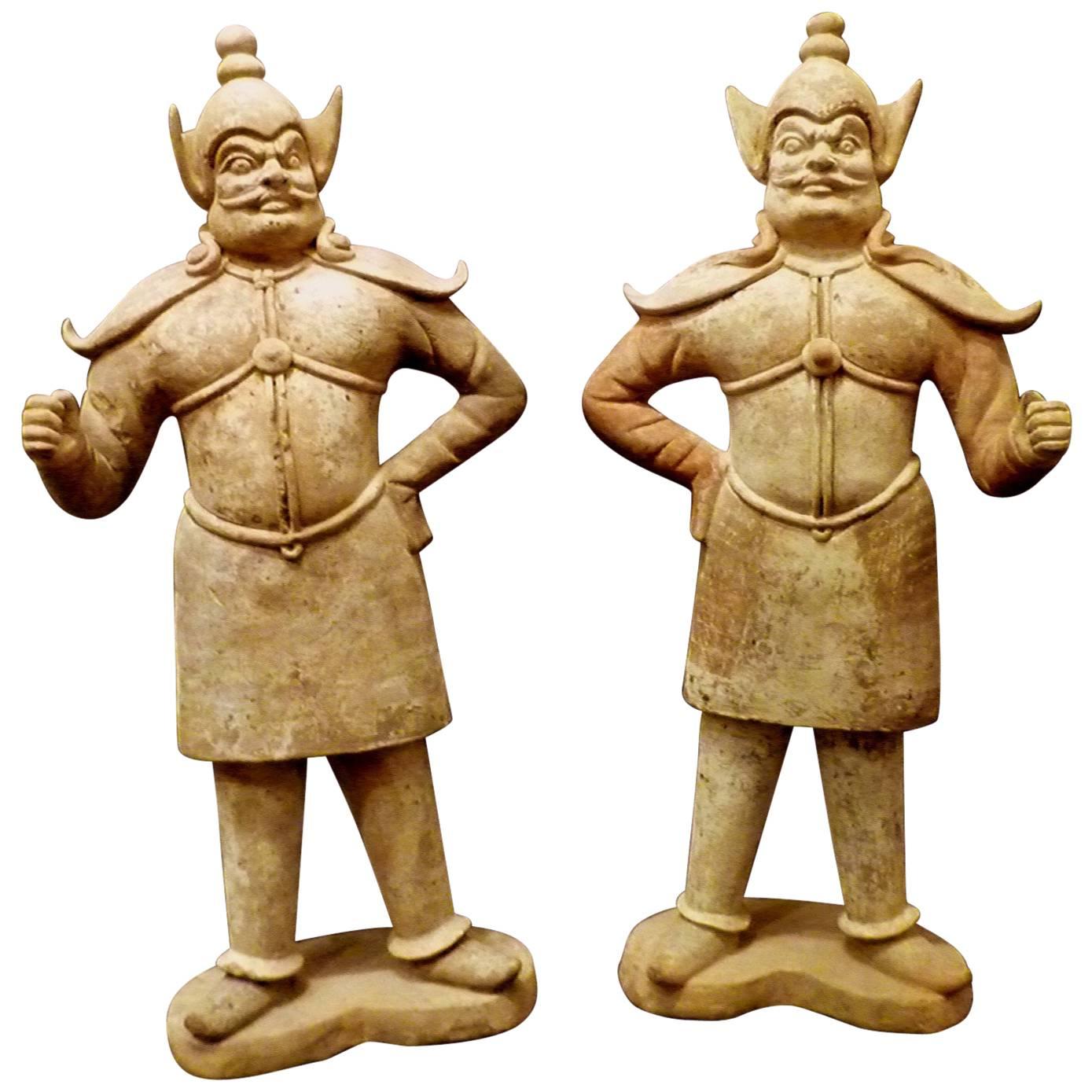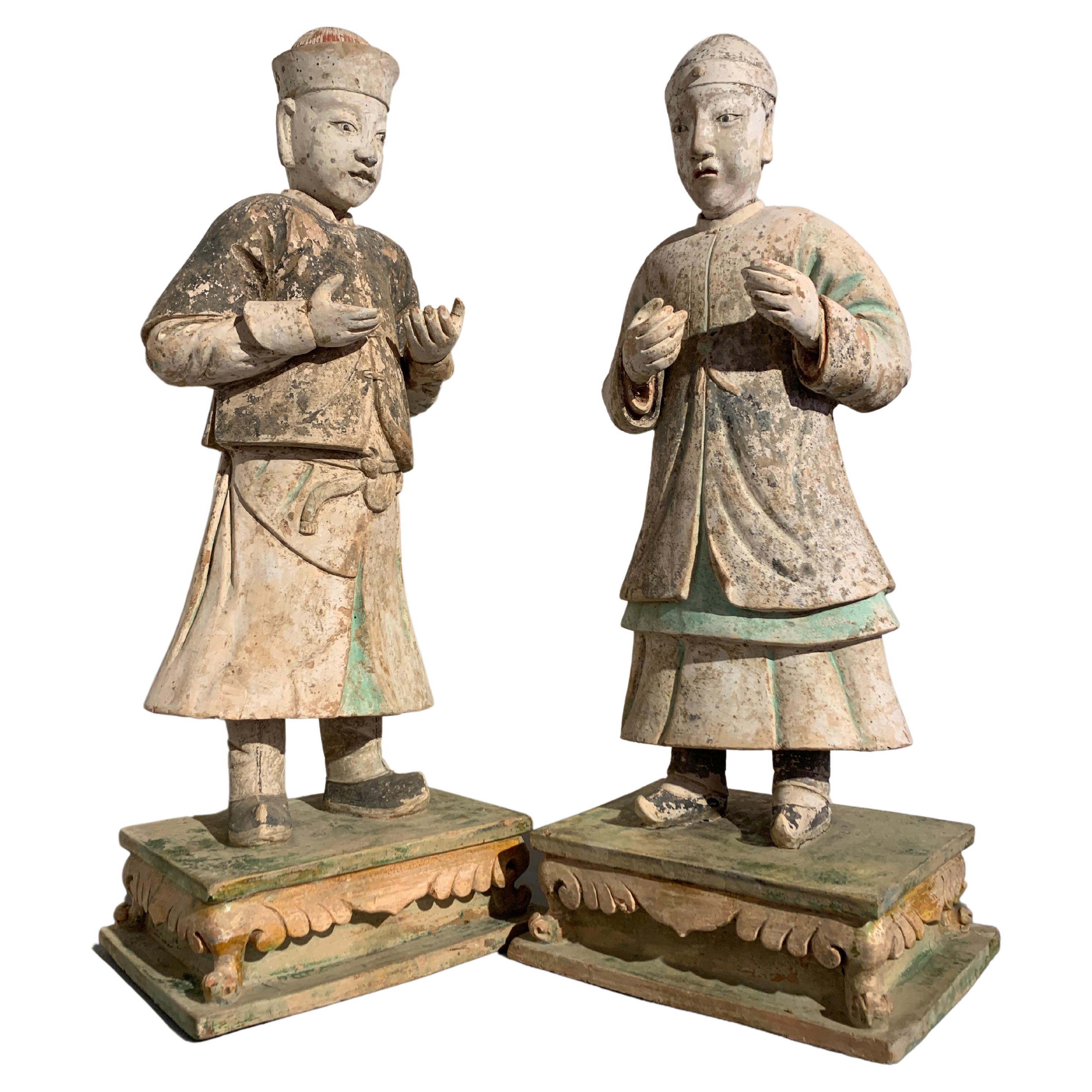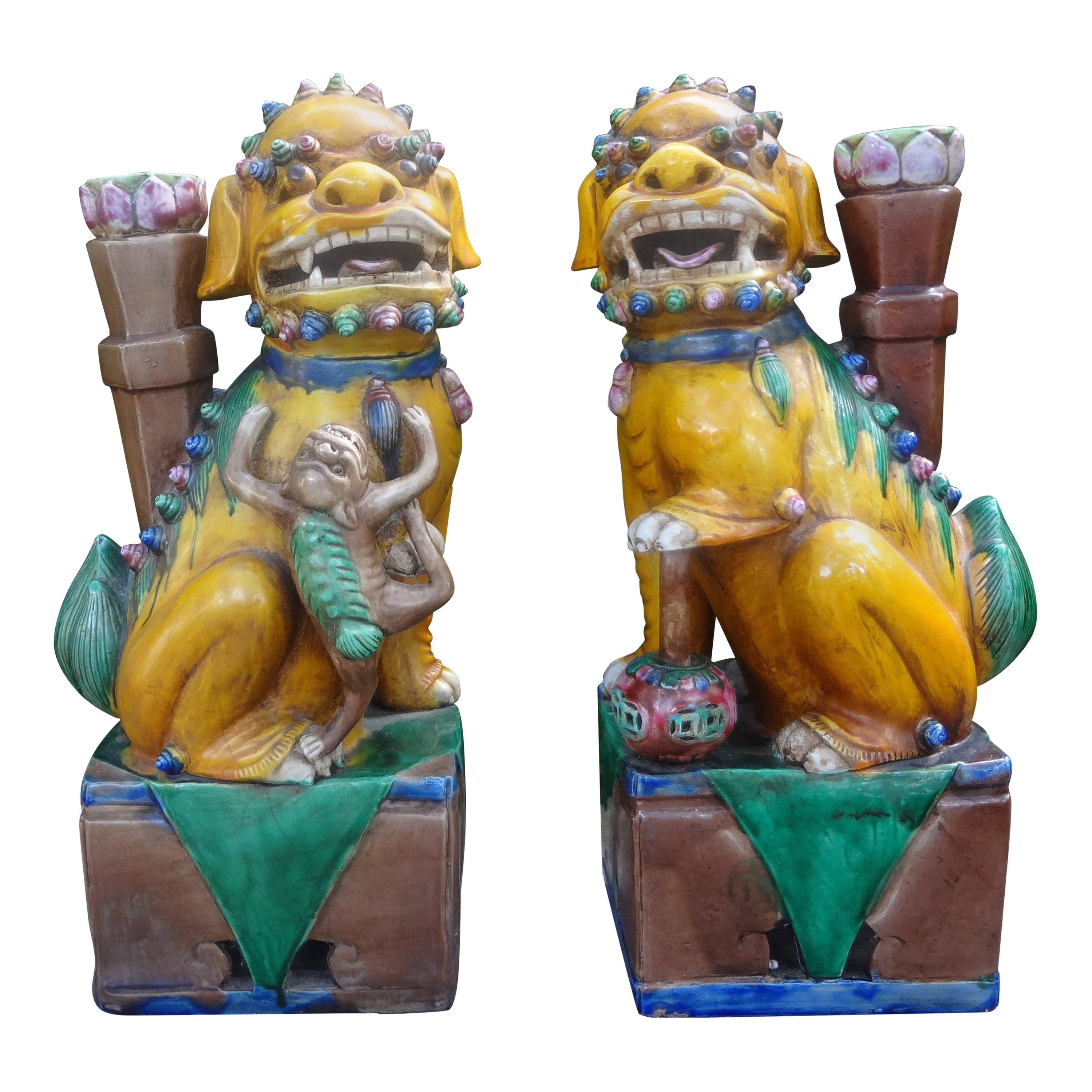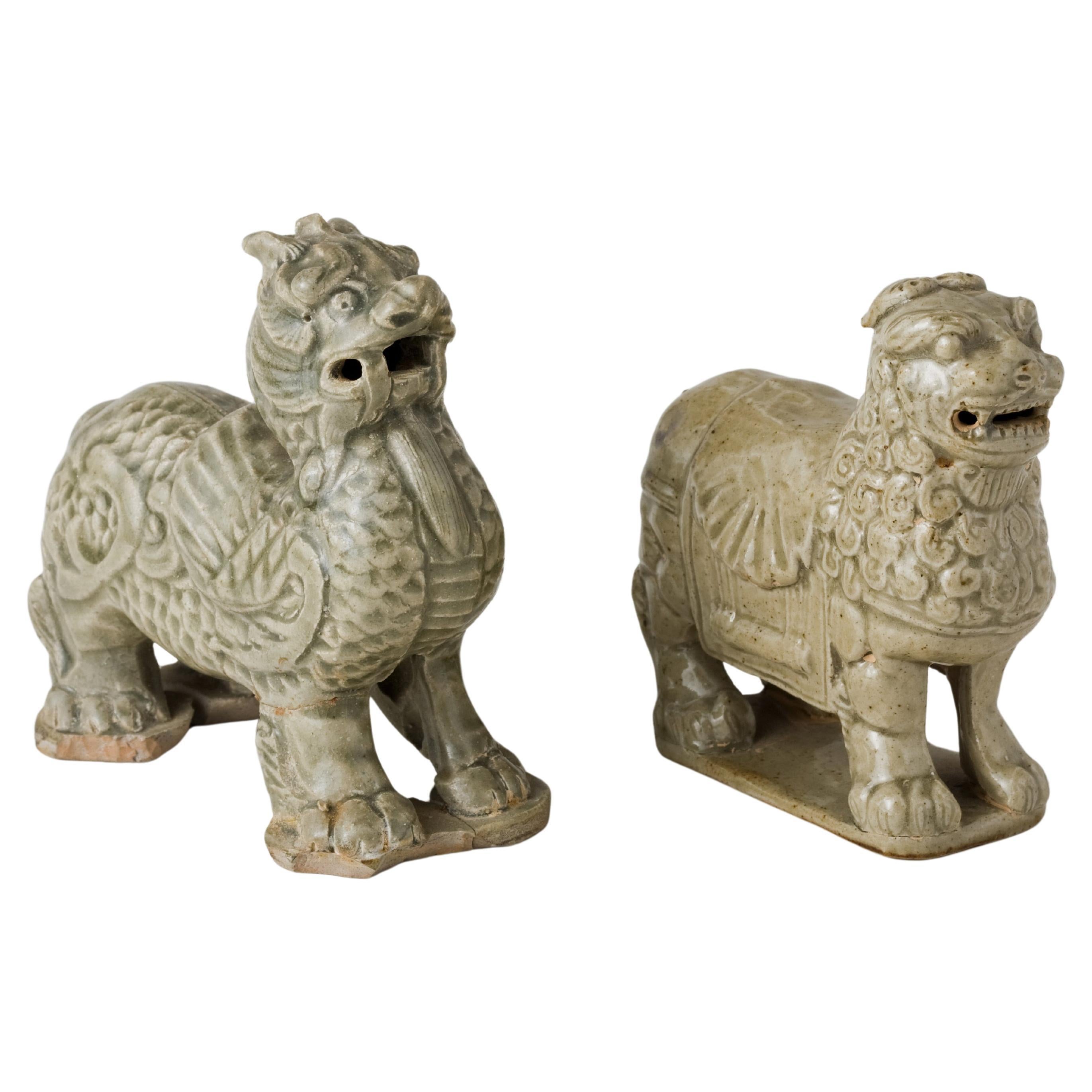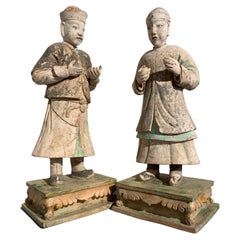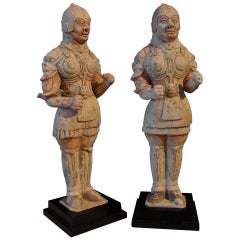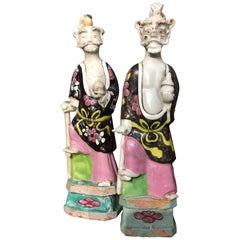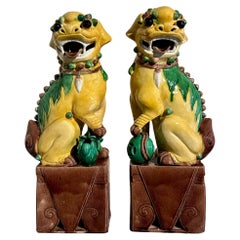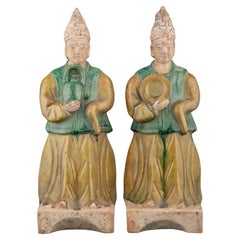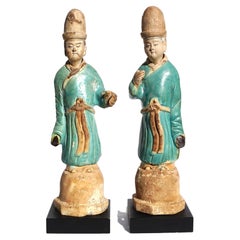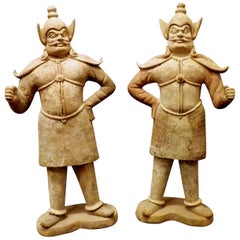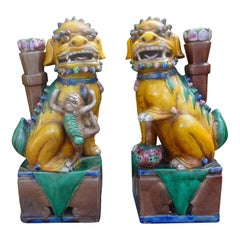Items Similar to Pair of Tang Dynasty Sancai Glazed Tomb Guardians, Zhenmushou, 7th-8th Century
Want more images or videos?
Request additional images or videos from the seller
1 of 16
Pair of Tang Dynasty Sancai Glazed Tomb Guardians, Zhenmushou, 7th-8th Century
$55,000per set
£41,475.46per set
€47,968.36per set
CA$77,164.71per set
A$85,773.37per set
CHF 44,960.56per set
MX$1,047,500.32per set
NOK 561,306.64per set
SEK 528,084.84per set
DKK 358,021.90per set
About the Item
A fantastic and powerful pair of Chinese Tang Dynasty three-color (sancai) glazed zhenmushou, tomb guardian figures, late 7th or early 8th century. TL tested by Oxford Authentication, 1998.
The fierce, mythical creatures are masterfully composed. They are portrayed perched upon hollow rock-work bases, seated firmly on their haunches, a pair of leaf shaped "wings" rising from their muscular shoulders.
One has a human-like face, mouth closed, with large elephantine ears, a large single horn rising from his head.
The other figure has a leonine face, surrounded by a mane. Its mouth open with sharp teeth bared and topped by a pair of tall antlers.
Both with large mohawk like crests or cockscombs rising from the center of their heads. One shaped like the blade of a halberd, the other shaped like flames.
The figures covered in a stunning sancai (three color) glaze, with cream, amber and green. The glaze with wonderful spots and runs, covering almost the entirety of the figures, save the lower part of the bases, the human-like face, and the large rising crests.
Zhenmushou are chimeric beings that were thought to ward off evil, protecting the occupant and contents of a tomb from physical and spiritual incursions.
For a comparable example of the guardian with the human face, see the Metropolitan Museum of Art, accession number 11.83.4
- Dimensions:Height: 29 in (73.66 cm)Width: 9 in (22.86 cm)Depth: 7 in (17.78 cm)
- Sold As:Set of 2
- Style:Tang (Of the Period)
- Materials and Techniques:Earthenware,Glazed
- Place of Origin:
- Period:
- Date of Manufacture:Late 7th to Early 8th Century
- Condition:Repaired: Repairs and restorations as expected. Wear consistent with age and use. Minor losses. Excellent condition for age. With repairs and restorations as expected. The top of the flange on the leonine figure with small losses.
- Seller Location:Austin, TX
- Reference Number:1stDibs: LU894712492912
About the Seller
5.0
Gold Seller
Premium sellers maintaining a 4.3+ rating and 24-hour response times
Established in 2001
1stDibs seller since 2010
347 sales on 1stDibs
Typical response time: 1 hour
- ShippingRetrieving quote...Shipping from: Austin, TX
- Return Policy
Authenticity Guarantee
In the unlikely event there’s an issue with an item’s authenticity, contact us within 1 year for a full refund. DetailsMoney-Back Guarantee
If your item is not as described, is damaged in transit, or does not arrive, contact us within 7 days for a full refund. Details24-Hour Cancellation
You have a 24-hour grace period in which to reconsider your purchase, with no questions asked.Vetted Professional Sellers
Our world-class sellers must adhere to strict standards for service and quality, maintaining the integrity of our listings.Price-Match Guarantee
If you find that a seller listed the same item for a lower price elsewhere, we’ll match it.Trusted Global Delivery
Our best-in-class carrier network provides specialized shipping options worldwide, including custom delivery.More From This Seller
View AllPair Large Chinese Ming Dynasty Glazed and Painted Pottery Figures, 16th Century
Located in Austin, TX
A striking pair of large Chinese glazed and painted pottery figures, Ming Dynasty (1368 to 1644), circa 16th century, China.
The impressive and realistically modeled figures each portrayed standing upright upon a sancai (three color) glazed pedestal of kang table form.
The man is dressed in a short black surcoat over a long robe and pants, a smart cap upon his head. His face is warm and welcoming, with wide eyes and a slight smile on his lips. He holds his hands out in front of him, palms up, almost as if shrugging, though presumably originally holding an object or offering, now lost.
The woman of slightly smaller stature, and dressed in a longer surcoat over a long robe and skirt. She wears a fitted cap upon her head. Her hands also held out in front, grasping long lost objects. Her face is slightly more severe, with a somewhat pinched look, and slight frown upon her lips.
The size of these figures is remarkable, as is the realism and attention to detail, almost as if they were modeled after real people, as opposed to the more common and generic Ming Dynasty pottery...
Category
Antique 16th Century Chinese Ming Sculptures and Carvings
Materials
Pottery
Pair of Tang Dynasty Painted Pottery Soldiers
Located in Austin, TX
A well modelled pair of Tang dynasty painted pottery soldiers.
The warriors portrayed standing, dressed in form fitting, elaborate layered Armor with fitted helmets. The breastplate...
Category
Antique 15th Century and Earlier Chinese Tang Figurative Sculptures
Materials
Pottery
$25,000 / set
Pair Chinese Export Famille Rose Figures of Immortals, 18th Century, China
Located in Austin, TX
A near pair of Chinese export porcelain figures of the Taoist immortal Li Tieguai, Qing Dynasty, late 18th century, China.
The Daoist Immortal Li Tieguai, on of the Eight Immortals...
Category
Antique Late 18th Century Chinese Chinese Export Ceramics
Materials
Porcelain
Pair Vintage Chinese Yellow Glazed Tall Foo Dogs, Mid 20th Century, China
Located in Austin, TX
A fun and colorful pair of vintage Chinese famille jaune glazed porcelain tall (15") foo dogs or foo lions, Chinese export, early to mid 20th century, China.
The delightful pair of ...
Category
Mid-20th Century Chinese Chinese Export Sculptures and Carvings
Materials
Enamel
Pair Chinese Ming Dynasty Glazed Buddhist Lions and Attendants, 17th Century
Located in Austin, TX
A fantastic pair of large Chinese tileworks sancai glazed Buddhistic lions and attendants, late Ming Dynasty, first half of the 17th century, Shanxi, China. Presented on custom 20th century wood and lacquer table-form stands.
This pair of lions and attendants portray Buddhist lions...
Category
Antique Mid-17th Century Chinese Ming Sculptures and Carvings
Materials
Ceramic, Wood
Pair Chinese White Glazed Guanyin, Qing Dynasty, 18th Century, China
Located in Austin, TX
A sublime and rare pair of Chinese white glazed porcelain figures of Guanyin, attributed to Tang Ying (1682 - 1756), Qing Dynasty, Qianlong Period, China.
This ethereal pair of white glazed porcelain figures depict the revered Buddhist Goddess of Mercy, Guanyin. Guanyin is portrayed standing, wearing heavy robes that drape beautifully around her figure. Bare feet peek out from under the hem of the robes. Her hair piled in a high chignon and covered by a cowl. The treatment of the hair, finely textured, unglazed, and with remnants of darker pigment, is typical of works by Tang Yin (1682 - 1756), who was the head of the imperial porcelain works at Jingdezhen.
Guanyin's beatific face is set in a serene smile, with a small, flat nose, and downcast, heavily lidded, almond shaped eyes. A simple beaded necklace graces her chest. Her hands held out, and may have once held attributes.
The hands were originally removable, but have since been permanently attached.
The figures crafted of a fine porcelain and glazed all over in a supple white glaze.
One figure bears a label from the Rafi Mottahedeh collection to the back.
Provenance:
Chinese Porcelain Company...
Category
Antique 18th Century Chinese Qing Ceramics
Materials
Porcelain
You May Also Like
Chinese Ming Dynasty Antique Sancai Glazed Attendants Tomb Figure Pair
Located in Forney, TX
A pair of large antique Chinese polychrome ceramic attendants, Ming Dynasty (1368-1644).
Outstanding 500+ year old Sancai glazed earthenware pottery tomb figures, exceptionally executed figural form, exquisitely detailed, one holding a teapot, the other holding a charger, rising on rare sculptural plinth...
Category
Antique 15th Century and Earlier Chinese Ming Sculptures and Carvings
Materials
Ceramic, Earthenware
Pair Ming Dynasty Glazed Pottery Dignitary Figures
Located in Dallas, TX
A pair of Ming dynasty sancai blue glazed pottery figures.
Circa 1500 AD Ming Dynasty
I have owned over 250 ming tomb figures including over 80...
Category
Antique 16th Century Chinese Ming Figurative Sculptures
Materials
Pottery
Pair of Very Refined Tang Dynasty Pottery Statue of Guardians, Oxford TL Tested
Located in Greenwich, CT
A pair of very refined standing pottery statue of guardians, dramatic facial expression, beautiful detail, early Tang dynasty 618-907, come with one Oxford authentication TL test cer...
Category
Antique 15th Century and Earlier Chinese Tang Antiquities
Materials
Terracotta
$19,000 Sale Price
24% Off
Pair of Chinese Glazed Terracotta Foo Dogs
Located in Houston, TX
Pair of Chinese Glazed Terracotta Foo Dogs or Foo Lions.
Stunning antique Chinese foo dogs or foo lions which date to the 1920's. This unusual pair of Chinese export foo dogs with ex...
Category
Vintage 1920s Chinese Chinese Export Ceramics
Materials
Terracotta
Rare Yue Celadon-Glazed Two Haitai Statues, Western Jin dynasty (265-420)
Located in seoul, KR
The statue seems to be a mythical beast standing in a poised and alert stance, with its mouth open as if roaring or breathing fire. Its body is covered in detailed carvings that resemble scales and feathers, indicative of the high level of craftsmanship during the Jin Dynasty. The creature’s presence is both regal and intimidating, suggesting it might have been believed to possess protective properties.
Period : Western Jin Dynasty (266 - 316 AD)
Type : Haitai Statue
Medium : Yue celadon...
Category
Antique 15th Century and Earlier Hong Kong Chinese Export Antiquities
Materials
Celadon
Pair of Terracotta Han Guards in Polychrome Paint China Han-Dynastie, TL Tested
Located in Salzburg, AT
Pair of terracotta Han guardsmen in polychrome paint China TL tested
Pair of rare standing male terracotta sculptures/warriors of the Chinese Han dynasty from the 2nd century BC.
W...
Category
Antique 15th Century and Earlier Chinese Han Figurative Sculptures
Materials
Terracotta, Acrylic
